The Moto E (2015) Review
by Brandon Chester on April 21, 2015 8:00 AM EST- Posted in
- Smartphones
- Motorola
- Mobile
- Moto E (2015)
GPU Performance
The Adreno 306 GPU in Snapdragon 410 is more or less just a variant of the Adreno 305 used in the Snapdragon 400 series SoCs. Because of this, there's not likely to be much improvement in terms of overall GPU performance when comparing the Moto E to older Snapdragon 400 devices like the One Mini 2 or the Moto G.
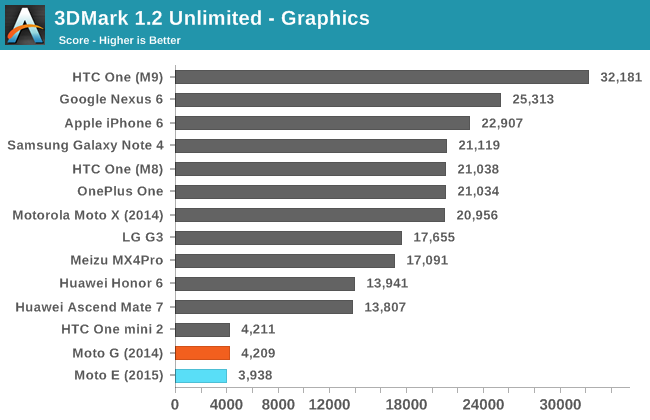
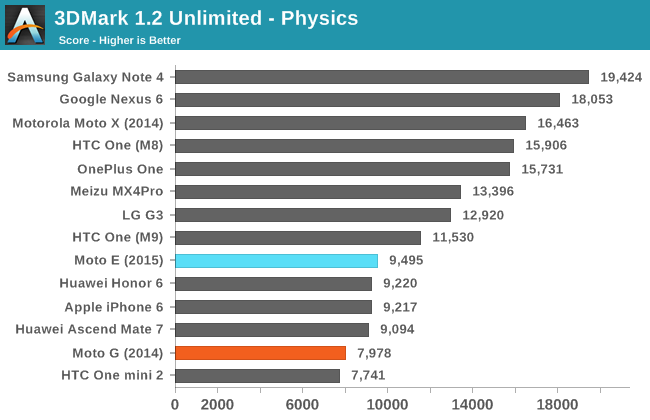

As expected, Adreno 306 performs roughly the same as Adreno 305. In the graphics test the Moto E does slightly worse than the Moto G, while it does substantially better in the physics test. Due to the heavier weighting of the graphics test, and the harmonic mean used to calculate the overall score, the Moto E actually performs every so slightly worse than the Moto G overall. I would consider the difference in graphics scores to be within the margin of error, and in general users can expect essentially the same level of performance from Adreno 306 as that of Adreno 305.
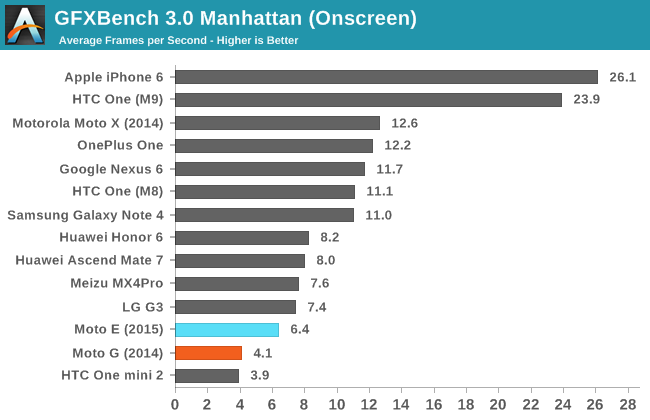

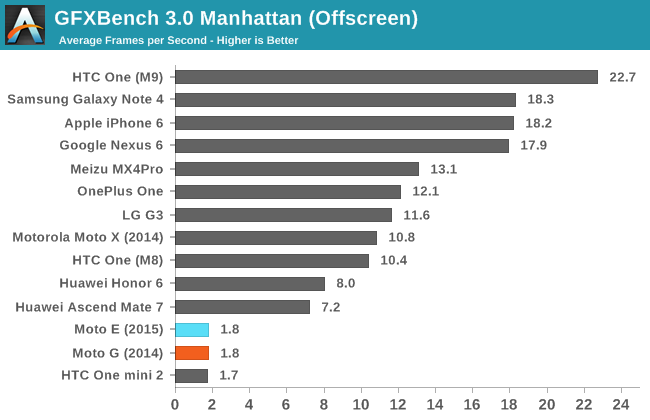
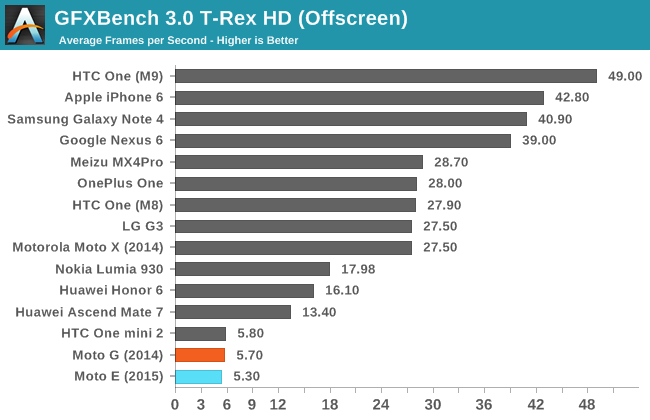
While I would normally run BaseMark X after 3DMark, a GPU driver bug prevents the test from finishing properly and no results are reported. Because of this, our last GPU test is GFXBench 3.0. In both T-Rex HD and Manhattan, the offscreen performance of Adreno 306 is roughly comparable to that of Adreno 305 in Snapdragon 400. Onscreen performance pulls ahead of the Moto G due to the Moto E's lower display resolution.
Overall, the GPU performance of the 2015 Moto E is what you'd expect from a budget device. It would be nice if there was a larger performance improvement over Snapdragon 400, but Motorola can't be faulted for that. Buyers shouldn't expect to be able to play any intensive 3D games, but the performance is more than sufficient for simple 2D games and rendering the Android interface.
NAND Performance
NAND performance is another important aspect of mobile devices. While in the PC world vendors will sometimes make note of their HDD/SSD speeds, in the mobile world we haven't reached a point where anything beyond the amount of flash memory is stated by manufacturers. Despite this, poor NAND can be a serious bottleneck of system performance whenever something is being loaded from the internal storage, or when a background app is doing reads and writes or downloading updates.
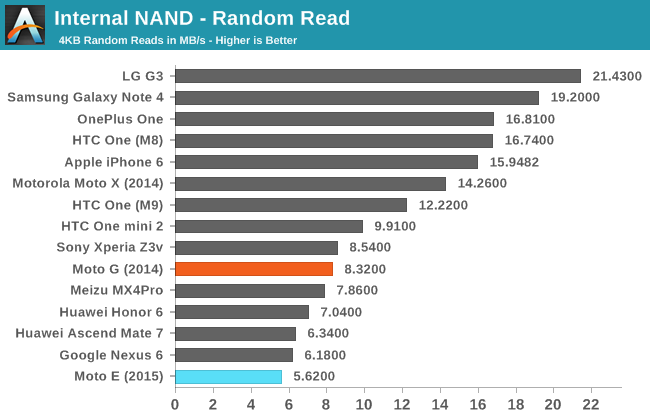
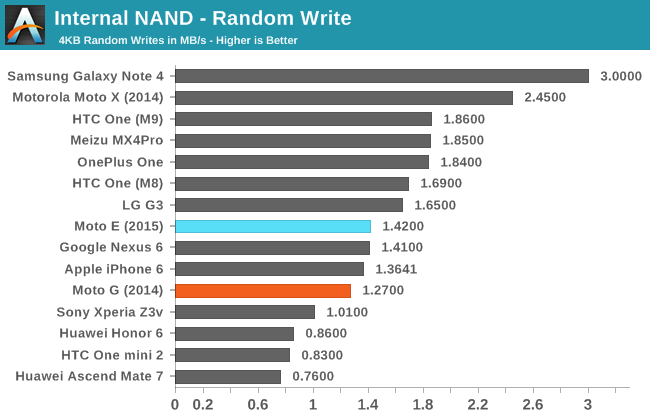
Random read speeds on the Moto E are fairly slow, and random writes are right in the middle of our comparison devices. While I don't think the random write will cause any issues, the slow random read speed may contribute to some slowness whenever applications are loading files.
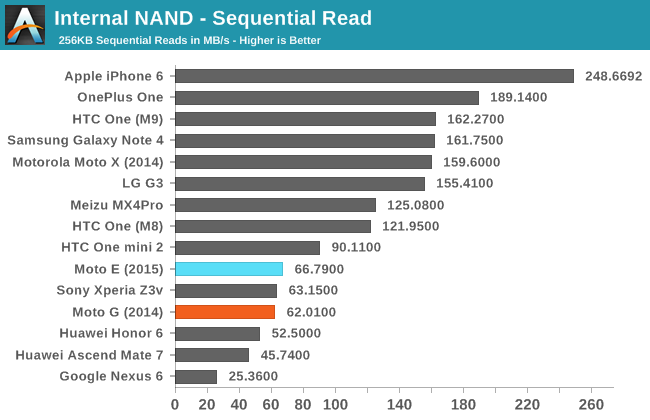
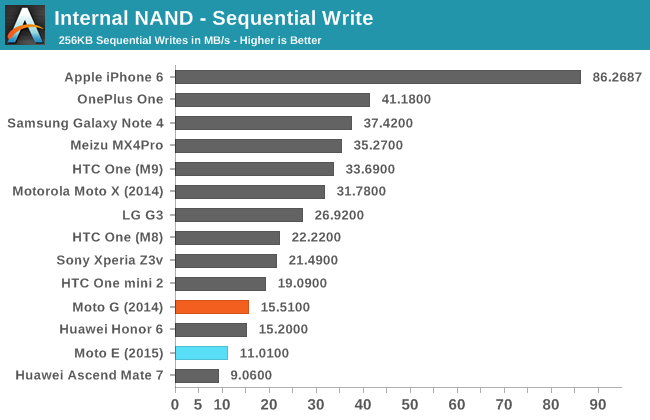
For those who are keeping track, the Moto E does not come with Android's full device encryption (FDE) enabled by default. Google appears to have stepped back from requiring FDE, and instead just recommends that it be enabled. Despite it not being enabled on the Moto E, the sequential read performance is not quite as fast as some other budget devices like the One Mini 2, although it is in line with the 2014 Moto G. Sequential write performance is unfortunately one of the lowest results on our list, although with only 5GB of accessible storage I don't imagine users will be writing many large files where it becomes a noticeable issue.










90 Comments
View All Comments
zepi - Tuesday, April 21, 2015 - link
How much does a 1A or 2A rated charger drop the charging times?I think it is a bit silly to compare chargers instead of phones.
arnoudw - Tuesday, April 21, 2015 - link
Exactly. I reviewed the phone as well (the European version) and the one that's for sale on this side of the ocean hasn't got a charger at all in the box. I just used another charger that I have to charge the phone and charge times were pretty normal: around 2,5 hours from zero to full.AT would maybe consider a disclaimer that chargers can differ per country or region and that can infuence the outcome of this particular test immensely. AT has got a worldwide audience and a lot of the potential buyers of this phone reading the review here might be from another part of the world. That's something for AT to consider, I guess.
TLDR; tested it as well, there was no charger included, charges normally with another charger.
sovking - Tuesday, April 21, 2015 - link
I agree. Charge time comparison should be done with the same charger or better with 2 or 3 chargers.Chargers for smarphone are universal, all devices connect to micro-usb chargers with 5V. At home we have more chargers for more smartphone and we do not matter which charger we are using.
So create a table showing a charging time when using 0.5A, 1A charger, 2A charger.
Some smartphone like Moto G 2014, limit input current, so it worth using until 1.5 A charger, more current is not used.
Ryan Smith - Tuesday, April 21, 2015 - link
To be clear here, the purpose is to test the charge time of the phone in its default configuration. It's not to compare just the chargers, but the entire package.hans_ober - Tuesday, April 21, 2015 - link
You've got a point; anyone who is buying this as their first Android (upgrading from an old Nokia), will most probably use the included charger and it was right to include the charge time using the 'package' the user would most probably use. However, since this is a case where the charger is to blame for the slow charging speeds, it would have been useful to include another result with another high powered charger, which would confirm that the phone IS capable of higher charging speeds if another charger is used and how much time could probably be saved by using a high powered charger.hans_ober - Wednesday, April 29, 2015 - link
Do you have a Quick charge 2.0 charger? The Motorola Turbo Charger? Just curious to see whether it works, because iirc QC 2.0 support was mentioned somewhere.victorson - Tuesday, April 21, 2015 - link
There is a mistake, the Moto E is not $109, it's actually $120 for the slow Snapdragon 200 version, and a not-so-cheap $150 for the Snadpragon 400 version. It's funny how the author can't think of competition when you have devices from Xiaomi and Meizu (among tens if not hundred others) that deliver better value for the money.close - Tuesday, April 21, 2015 - link
In EU the Moto E LTE is ~130E while the cheapest Xiaomi starts at ~170E. I wouldn't think twice.Brandon Chester - Tuesday, April 21, 2015 - link
The number of markets that you can purchase Xiaomi phones in is extremely small, you can count them on one hand. Also I apologize about the pricing error. There have been a few sales on it recently and for whatever reason I noted the price as $109. That being said, it does drop below Motorola's price very often. For example, it's currently available in India on Flipkart for $127 USD. India does happen to be an Xiaomi market and so I would definitely urge buyers there to check out their devices as well. But that's not an option for most buyers.victorson - Tuesday, April 21, 2015 - link
Thanks for the reply, Brandon! I agree that you can get the phone cheaper on sales and I wouldn't argue against the Moto E being an overall good value for the money, but it's also true that you can buy said Xiaomi phones (or many others for that matter, I don't want this to sound like an ad) from retailers like Pandawill.com, Coolicool.com, or others that ship internationally for free. And the user who said that Xiaomi starts at 170 euro, may want to pay a visit and see that prices on those sites start at around $120, not 170 euro.